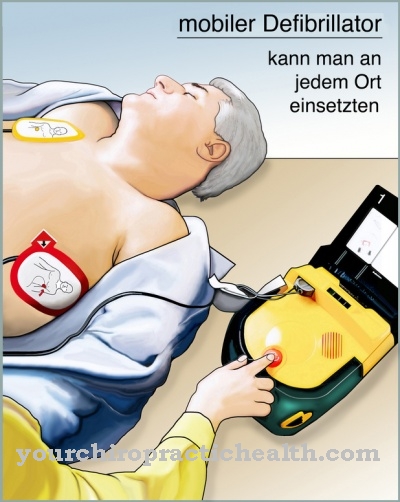As Swan-Ganz catheter a cardiac catheter for right heart catheter examinations is known which, in addition to measuring pressure, also determines cardiac output. The balloon catheter is inserted into the right ventricle and the pulmonary artery through a central nervous access. It is mainly used in intensive care monitoring.
What is a Swan-Ganz catheter?
The Swan-Ganz catheter was developed in 1970 by cardiologists W. Ganz and H. J. Swan. It is a cardiac catheter for the right ventricle, which is used to measure pressure and determine cardiac output.
The examinations with the Swan-Ganz catheter are also known as right heart catheter examinations. This examination is mainly used to monitor the cardiovascular situation in intensive care patients or during anesthesia.
The catheter is laid percutaneously through a central nervous access. The catheter reaches the right ventricle through the right atrium of the heart and is advanced into the trunk of the pulmonary artery. Its use is associated with numerous risks, but these rarely occur. Nevertheless, the patient is informed beforehand about the risk of nerve injuries, injured heart structures, vascular damage, thrombosis and embolism.
Shapes, types & types
The Swan-Ganz catheter is usually a balloon catheter. These are mainly used in angioplasty or urinary bladder catheterization. Balloon catheters are plastic catheters with a balloon with compressed air or liquid at the tip. The balloon can unfold and is also known as an occlusion balloon.
If cardiac output is to be measured in addition to pressure, a thermistor catheter is used. Such a device measures the temperature thinning curve in the heart and calculates the volume that the heart ejects per minute. Like the balloon catheter, the thermistor catheter is also a three-lumen catheter. The individual lumina are separated from one another.
As a cardiac catheter, the Swan-Ganz catheter is one of the right heart catheters in all forms. For right heart catheters, a vein in the groin is usually punctured. The puncture enables the introduction of a cannula and a guide probe. The cannula is removed again via the guide probe and the cardiac catheter can be inserted.
Structure & functionality
The Swan-Ganz catheter is made up of several individual units. In addition to a balloon, it includes a double-lumen catheter with X-ray markings, a pressure measuring chip and a syringe for the balloon. The lumen of the structure can be expanded or closed using the inflatable balloon. During an operation, for example, the blood flow can be temporarily interrupted.
As a rule, the balloon is inflated with one milliliter of air via the syringe. The heartbeat then moves the balloon into the wedge position. It is thus fixed in a branch of the pulmonary artery. The catheter is connected to the individual measuring devices via various connections. The pressure measurement takes place by means of the pressure chip in the right atrium, in the right ventricle and in the pulmonary artery. This pressure measurement allows conclusions to be drawn about the function of the heart cavities.
Information can also be collected in this way with regard to lung function and the body's own water balance. The pulmonary catheter is therefore mainly used in anesthesia and for patients with cardiac insufficiency or for cardiovascular surgery.
Intensive care medicine also uses the catheter for patients in shock. Such shock states can be cardiogenic shocks, septic shocks or polytraumatic hypovolemic shocks. The measuring devices evaluate the information from the pressure chip and provide pressure values. With these values, the intensive care physician can ideally determine the cause of a state of shock and thus decide on a specific treatment. For example, he can clarify whether drug treatment is sufficient or whether a surgical procedure such as a puncture of the pericardium is necessary.
Medical & health benefits
The Swan-Ganz catheter can be used to determine various pressure levels in the heart and nearby structures. For example, the pulmonary artery can be closed by the balloon of the catheter. The resulting pressure is known as pulmonary artery occlusion pressure and is also known as wedge pressure. This pressure is used indirectly to determine end-diastolic pressure conditions in the left heart ventricle. Such a determination may be necessary for indications for pulmonary angiography. Such indications include pulmonary embolism, an arteriovenous pulmonary fistula, pulmonary valve insufficiency or a planned mitral or aortic valve replacement.
The indication for dextrocardiography can also make the Swan-Ganz catheter necessary. Such an indication arises with disorders of the tricuspid and pulmonary valve, with right-left shunt vitia or atrial septal defects and malfunctioning pulmonary veins. In addition, left ventricular malfunctions can make the pressure measurement described necessary. Such disorders can arise, for example, from left heart failure, in the context of pulmonary hypertension or from cor pulmonale.
Since the Swan-Ganz catheter can also be used to determine cardiac output, it is also of medical use in bradycardias, pronounced tachycardias, structurally ischemic heart changes or changed heart loads. It can be used just as much for valve damage, filling obstructions, pericardial tamponades and thoracic deformities.
In addition to its function as a monitoring instrument, the Swan-Ganz catheter also has a function as a diagnostic instrument for therapy planning. Despite the associated risks, a catheter has a correspondingly high medical benefit and is therefore often used on seriously ill patients.

















.jpg)



.jpg)

.jpg)




